Lenovo Strategic Analysis
VerifiedAdded on 2020/02/05
|16
|4341
|104
AI Summary
This assignment delves into a strategic analysis of Lenovo utilizing the SWOT and TOWS matrices. It examines Lenovo's strengths like its strong brand image and quality products, alongside weaknesses such as a need for increased product innovation. The analysis also explores opportunities in environmental-savy products and market growth, while considering threats from low-cost competitors and exclusive competitor technologies. Various tools including the Ansoff Matrix, SPACE Matrix, BCG Matrix, and GE Matrix are utilized to provide a multifaceted perspective on Lenovo's strategic landscape.
Contribute Materials
Your contribution can guide someone’s learning journey. Share your
documents today.
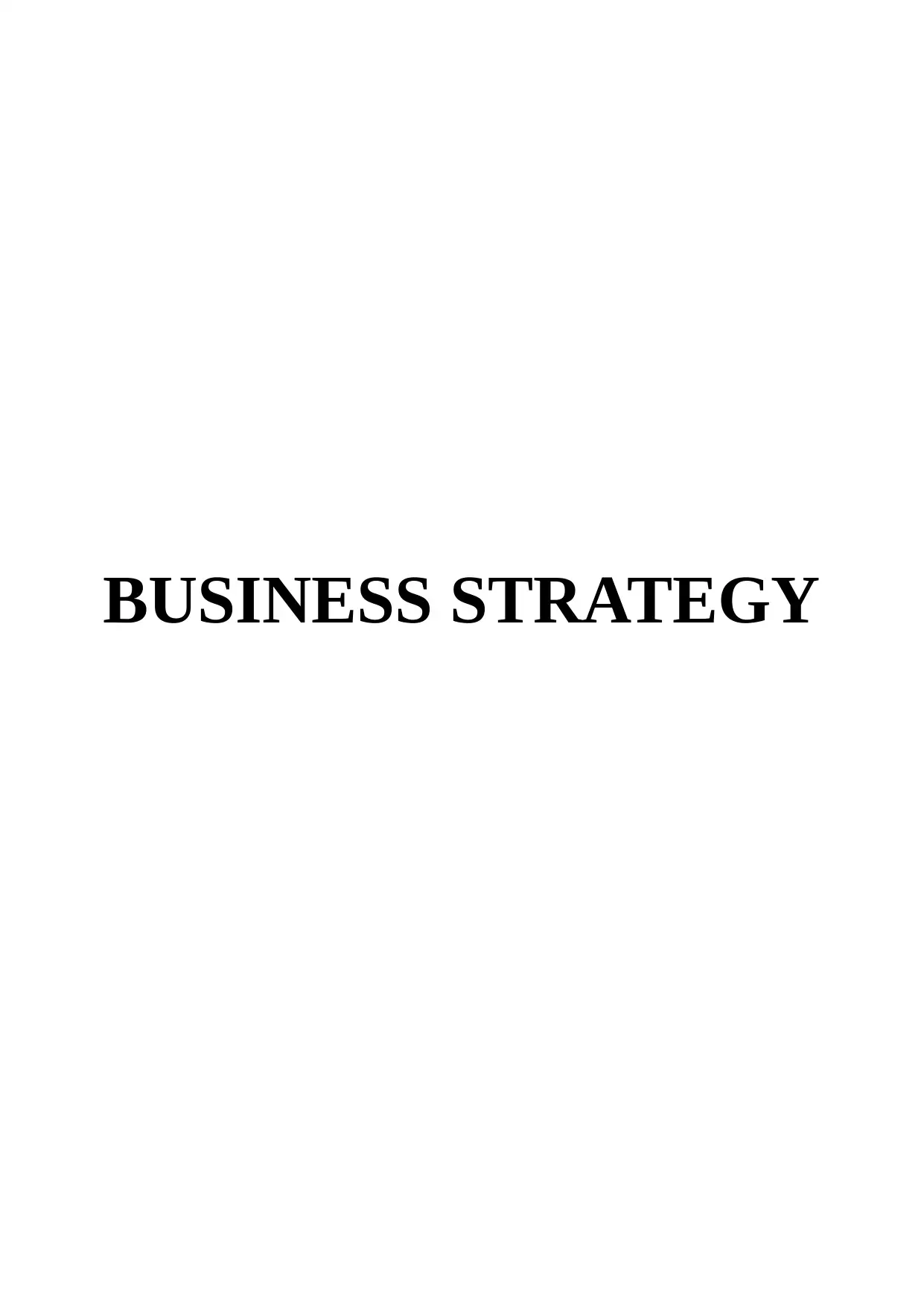
BUSINESS STRATEGY
Secure Best Marks with AI Grader
Need help grading? Try our AI Grader for instant feedback on your assignments.

TABLE OF CONTENTS
INTRODUCTION................................................................................................................................4
POSITIONING OF LENOVO.............................................................................................................4
IBM ACQUISITION BY LENOVO GROUP LTD...........................................................................13
FUTURE SCENARIOS FOR LENOVO...........................................................................................14
CONCLUSION..................................................................................................................................15
REFERENCES...................................................................................................................................16
INTRODUCTION................................................................................................................................4
POSITIONING OF LENOVO.............................................................................................................4
IBM ACQUISITION BY LENOVO GROUP LTD...........................................................................13
FUTURE SCENARIOS FOR LENOVO...........................................................................................14
CONCLUSION..................................................................................................................................15
REFERENCES...................................................................................................................................16

ILLUSTRATION INDEX
Illustration 1: Supply chain..................................................................................................................4
Illustration 2: SPACE Matrix................................................................................................................6
Illustration 3: BCG Matrix.................................................................................................................10
Illustration 4: GE Matrix....................................................................................................................11
Illustration 1: Supply chain..................................................................................................................4
Illustration 2: SPACE Matrix................................................................................................................6
Illustration 3: BCG Matrix.................................................................................................................10
Illustration 4: GE Matrix....................................................................................................................11
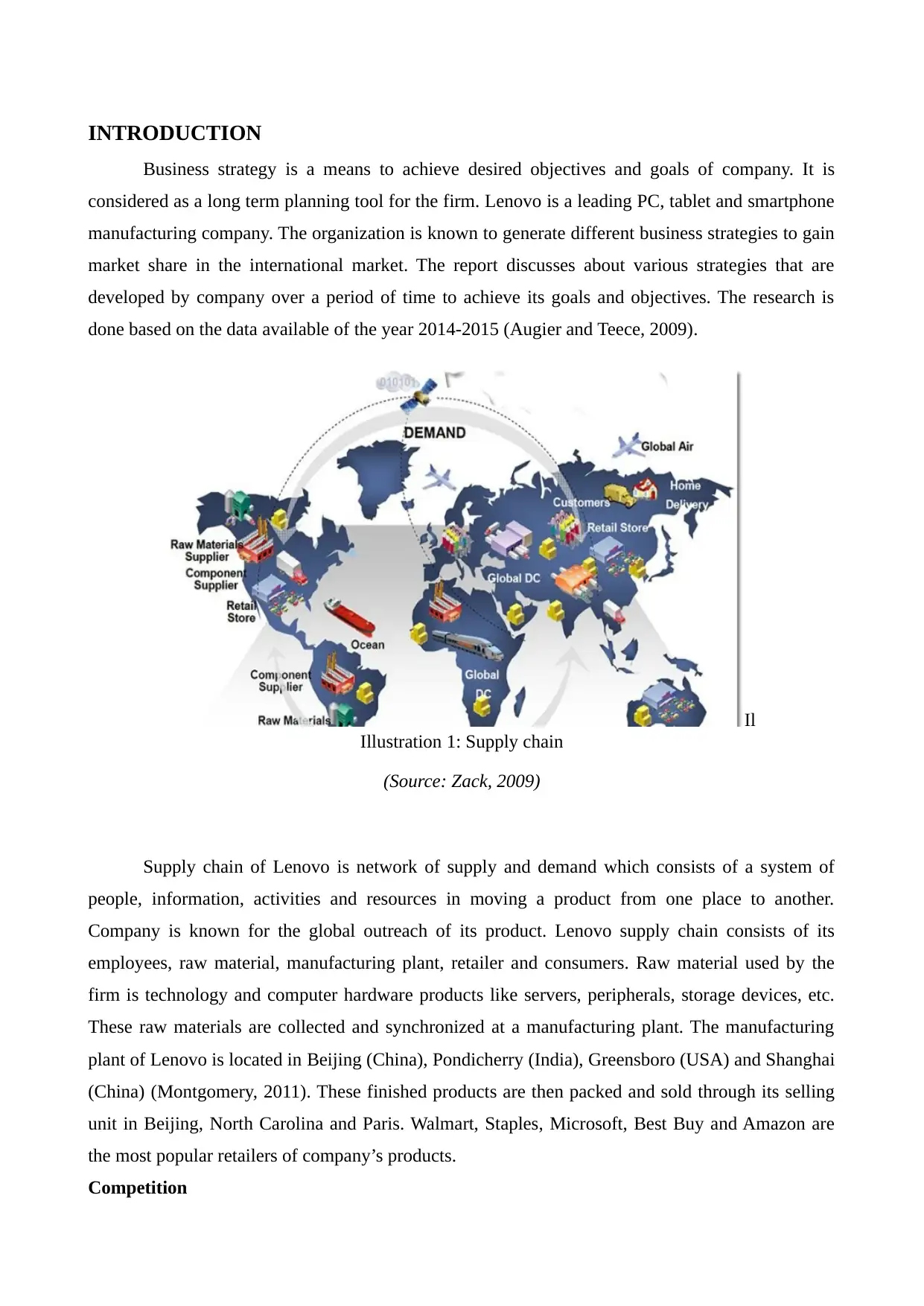
INTRODUCTION
Business strategy is a means to achieve desired objectives and goals of company. It is
considered as a long term planning tool for the firm. Lenovo is a leading PC, tablet and smartphone
manufacturing company. The organization is known to generate different business strategies to gain
market share in the international market. The report discusses about various strategies that are
developed by company over a period of time to achieve its goals and objectives. The research is
done based on the data available of the year 2014-2015 (Augier and Teece, 2009).
Supply chain of Lenovo is network of supply and demand which consists of a system of
people, information, activities and resources in moving a product from one place to another.
Company is known for the global outreach of its product. Lenovo supply chain consists of its
employees, raw material, manufacturing plant, retailer and consumers. Raw material used by the
firm is technology and computer hardware products like servers, peripherals, storage devices, etc.
These raw materials are collected and synchronized at a manufacturing plant. The manufacturing
plant of Lenovo is located in Beijing (China), Pondicherry (India), Greensboro (USA) and Shanghai
(China) (Montgomery, 2011). These finished products are then packed and sold through its selling
unit in Beijing, North Carolina and Paris. Walmart, Staples, Microsoft, Best Buy and Amazon are
the most popular retailers of company’s products.
Competition
Il
Illustration 1: Supply chain
(Source: Zack, 2009)
Business strategy is a means to achieve desired objectives and goals of company. It is
considered as a long term planning tool for the firm. Lenovo is a leading PC, tablet and smartphone
manufacturing company. The organization is known to generate different business strategies to gain
market share in the international market. The report discusses about various strategies that are
developed by company over a period of time to achieve its goals and objectives. The research is
done based on the data available of the year 2014-2015 (Augier and Teece, 2009).
Supply chain of Lenovo is network of supply and demand which consists of a system of
people, information, activities and resources in moving a product from one place to another.
Company is known for the global outreach of its product. Lenovo supply chain consists of its
employees, raw material, manufacturing plant, retailer and consumers. Raw material used by the
firm is technology and computer hardware products like servers, peripherals, storage devices, etc.
These raw materials are collected and synchronized at a manufacturing plant. The manufacturing
plant of Lenovo is located in Beijing (China), Pondicherry (India), Greensboro (USA) and Shanghai
(China) (Montgomery, 2011). These finished products are then packed and sold through its selling
unit in Beijing, North Carolina and Paris. Walmart, Staples, Microsoft, Best Buy and Amazon are
the most popular retailers of company’s products.
Competition
Il
Illustration 1: Supply chain
(Source: Zack, 2009)
Secure Best Marks with AI Grader
Need help grading? Try our AI Grader for instant feedback on your assignments.
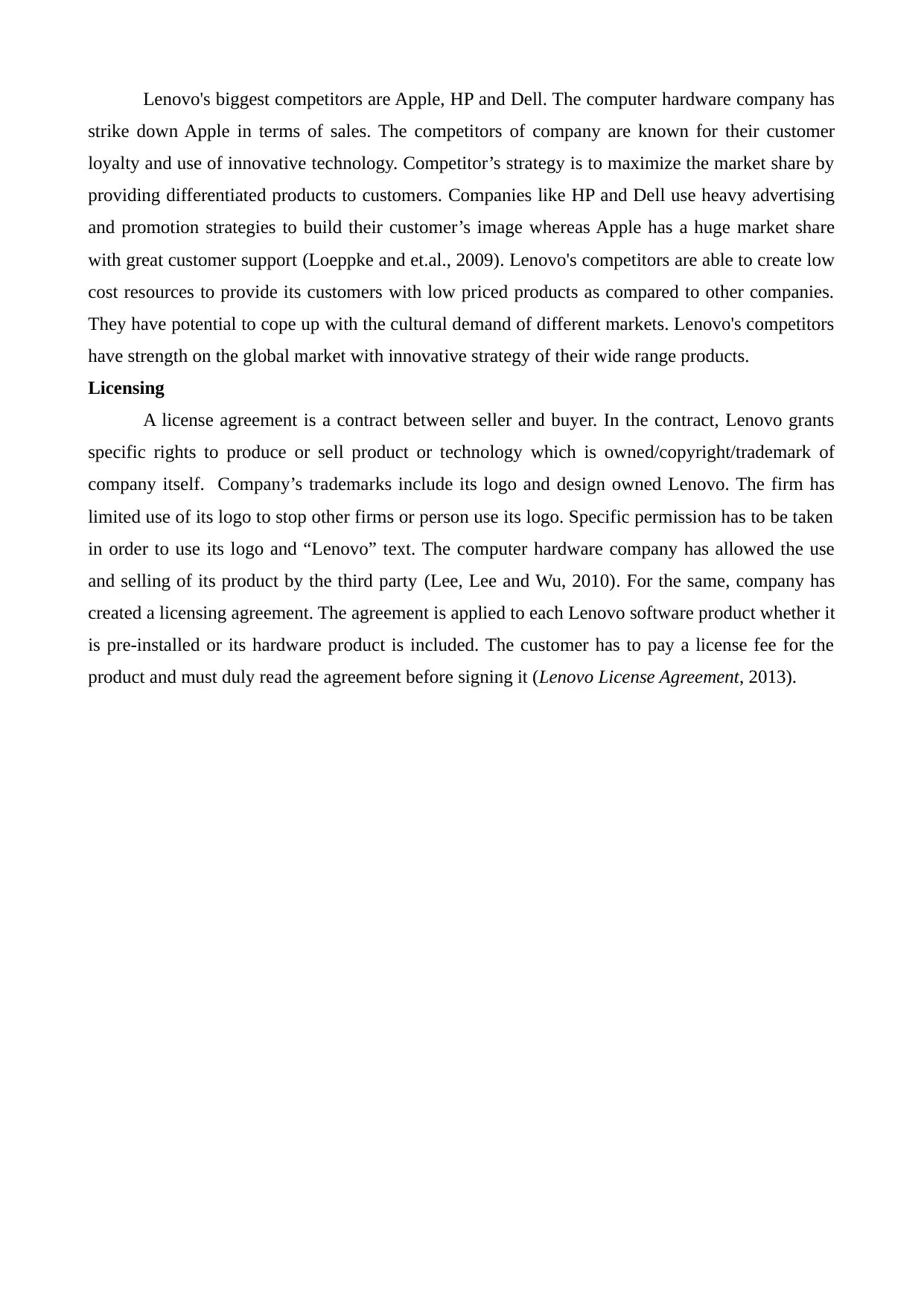
Lenovo's biggest competitors are Apple, HP and Dell. The computer hardware company has
strike down Apple in terms of sales. The competitors of company are known for their customer
loyalty and use of innovative technology. Competitor’s strategy is to maximize the market share by
providing differentiated products to customers. Companies like HP and Dell use heavy advertising
and promotion strategies to build their customer’s image whereas Apple has a huge market share
with great customer support (Loeppke and et.al., 2009). Lenovo's competitors are able to create low
cost resources to provide its customers with low priced products as compared to other companies.
They have potential to cope up with the cultural demand of different markets. Lenovo's competitors
have strength on the global market with innovative strategy of their wide range products.
Licensing
A license agreement is a contract between seller and buyer. In the contract, Lenovo grants
specific rights to produce or sell product or technology which is owned/copyright/trademark of
company itself. Company’s trademarks include its logo and design owned Lenovo. The firm has
limited use of its logo to stop other firms or person use its logo. Specific permission has to be taken
in order to use its logo and “Lenovo” text. The computer hardware company has allowed the use
and selling of its product by the third party (Lee, Lee and Wu, 2010). For the same, company has
created a licensing agreement. The agreement is applied to each Lenovo software product whether it
is pre-installed or its hardware product is included. The customer has to pay a license fee for the
product and must duly read the agreement before signing it (Lenovo License Agreement, 2013).
strike down Apple in terms of sales. The competitors of company are known for their customer
loyalty and use of innovative technology. Competitor’s strategy is to maximize the market share by
providing differentiated products to customers. Companies like HP and Dell use heavy advertising
and promotion strategies to build their customer’s image whereas Apple has a huge market share
with great customer support (Loeppke and et.al., 2009). Lenovo's competitors are able to create low
cost resources to provide its customers with low priced products as compared to other companies.
They have potential to cope up with the cultural demand of different markets. Lenovo's competitors
have strength on the global market with innovative strategy of their wide range products.
Licensing
A license agreement is a contract between seller and buyer. In the contract, Lenovo grants
specific rights to produce or sell product or technology which is owned/copyright/trademark of
company itself. Company’s trademarks include its logo and design owned Lenovo. The firm has
limited use of its logo to stop other firms or person use its logo. Specific permission has to be taken
in order to use its logo and “Lenovo” text. The computer hardware company has allowed the use
and selling of its product by the third party (Lee, Lee and Wu, 2010). For the same, company has
created a licensing agreement. The agreement is applied to each Lenovo software product whether it
is pre-installed or its hardware product is included. The customer has to pay a license fee for the
product and must duly read the agreement before signing it (Lenovo License Agreement, 2013).

SPACE Matrix
SPACE matrix analyses four different strategies of quadrants of Aggressiveness,
Conservative, Defensive and Competitive.
Financial Stability-
Lenovo's revenue reached to USD 46,000 million (Lenovo Group Ltd, 2015). The working
capital of company was USD (1,734) million, the operating cash flow was USD 238 million and the
return on investment was 16%. As company’s capital position is detrimental, the company in terms
of financial stability is given a score of 3 (Holbeche, 2009).
Competitive advantage-
Growth of company in terms of revenue for the year 2015 is 19% and its net income is
2.34% which shows that it has high growth potential in the mobile hardware industry. As per the
advantage on competitors, the CA score is -2.
Industry Strength-
Lenovo has gained competitive advantage over its competitors with innovation and customer
support services. IS score of Lenovo is 2.
Environmental Stability-
The firm has brought differentiated technological changes in the products. The market in
which company operates is not stable due to fluctuations brought by government regulations and
competitors. The ES score of company is -2 (Verbeke, 2013).
As per the given statistics, the SPACE matrix is like -
For example, internal dimension i.e. FS + ES= 3 + (-2) = 1
For example, external dimension i.e. CA + IS= 3+ (-2) = 1
Illustration 2: SPACE Matrix
(Source: Bryson and Lombardi, 2009)
SPACE matrix analyses four different strategies of quadrants of Aggressiveness,
Conservative, Defensive and Competitive.
Financial Stability-
Lenovo's revenue reached to USD 46,000 million (Lenovo Group Ltd, 2015). The working
capital of company was USD (1,734) million, the operating cash flow was USD 238 million and the
return on investment was 16%. As company’s capital position is detrimental, the company in terms
of financial stability is given a score of 3 (Holbeche, 2009).
Competitive advantage-
Growth of company in terms of revenue for the year 2015 is 19% and its net income is
2.34% which shows that it has high growth potential in the mobile hardware industry. As per the
advantage on competitors, the CA score is -2.
Industry Strength-
Lenovo has gained competitive advantage over its competitors with innovation and customer
support services. IS score of Lenovo is 2.
Environmental Stability-
The firm has brought differentiated technological changes in the products. The market in
which company operates is not stable due to fluctuations brought by government regulations and
competitors. The ES score of company is -2 (Verbeke, 2013).
As per the given statistics, the SPACE matrix is like -
For example, internal dimension i.e. FS + ES= 3 + (-2) = 1
For example, external dimension i.e. CA + IS= 3+ (-2) = 1
Illustration 2: SPACE Matrix
(Source: Bryson and Lombardi, 2009)
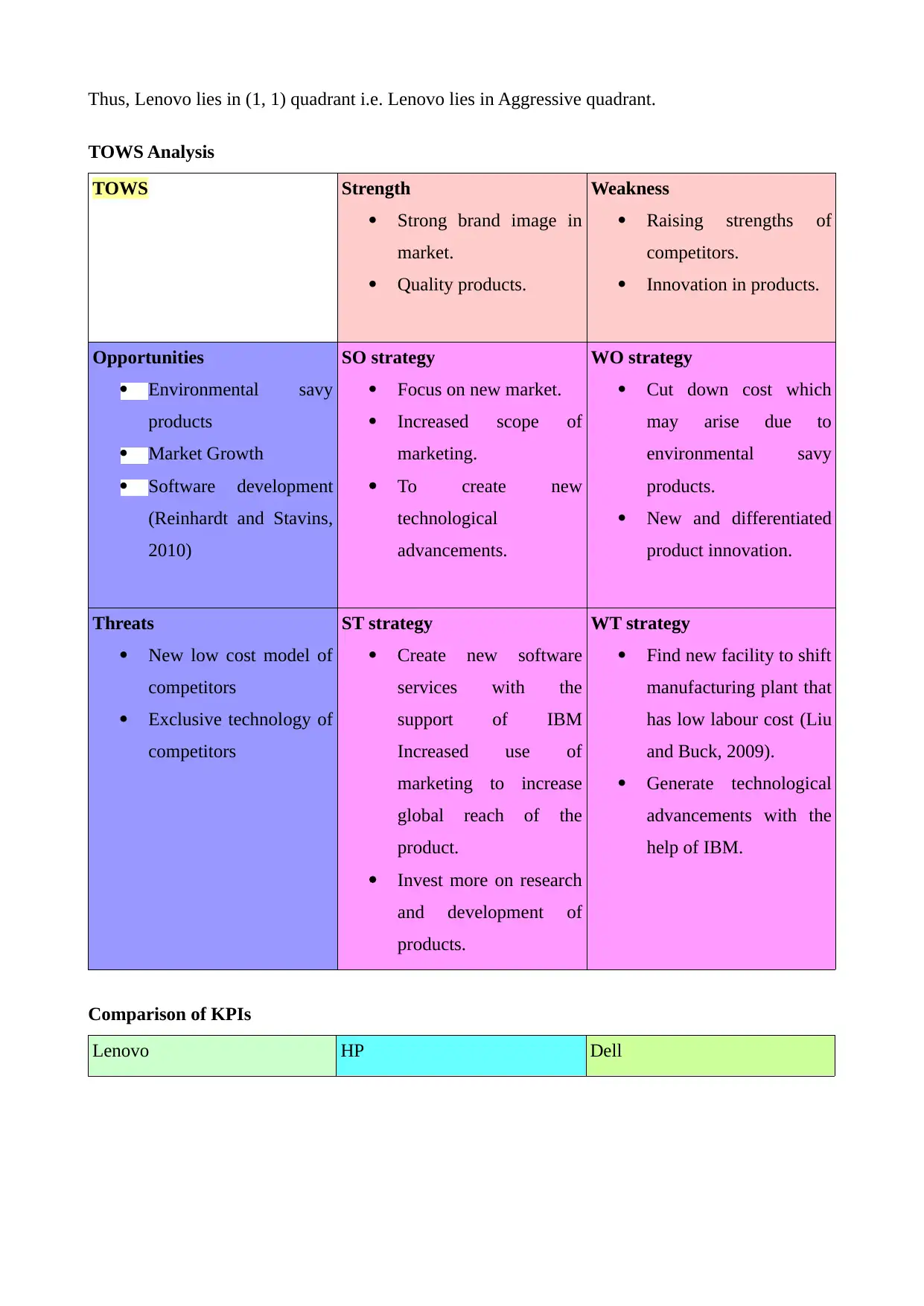
Thus, Lenovo lies in (1, 1) quadrant i.e. Lenovo lies in Aggressive quadrant.
Comparison of KPIs
Lenovo HP Dell
TOWS Analysis
TOWS Strength
Strong brand image in
market.
Quality products.
Weakness
Raising strengths of
competitors.
Innovation in products.
Opportunities
Environmental savy
products
Market Growth
Software development
(Reinhardt and Stavins,
2010)
SO strategy
Focus on new market.
Increased scope of
marketing.
To create new
technological
advancements.
WO strategy
Cut down cost which
may arise due to
environmental savy
products.
New and differentiated
product innovation.
Threats
New low cost model of
competitors
Exclusive technology of
competitors
ST strategy
Create new software
services with the
support of IBM
Increased use of
marketing to increase
global reach of the
product.
Invest more on research
and development of
products.
WT strategy
Find new facility to shift
manufacturing plant that
has low labour cost (Liu
and Buck, 2009).
Generate technological
advancements with the
help of IBM.
Comparison of KPIs
Lenovo HP Dell
TOWS Analysis
TOWS Strength
Strong brand image in
market.
Quality products.
Weakness
Raising strengths of
competitors.
Innovation in products.
Opportunities
Environmental savy
products
Market Growth
Software development
(Reinhardt and Stavins,
2010)
SO strategy
Focus on new market.
Increased scope of
marketing.
To create new
technological
advancements.
WO strategy
Cut down cost which
may arise due to
environmental savy
products.
New and differentiated
product innovation.
Threats
New low cost model of
competitors
Exclusive technology of
competitors
ST strategy
Create new software
services with the
support of IBM
Increased use of
marketing to increase
global reach of the
product.
Invest more on research
and development of
products.
WT strategy
Find new facility to shift
manufacturing plant that
has low labour cost (Liu
and Buck, 2009).
Generate technological
advancements with the
help of IBM.
Paraphrase This Document
Need a fresh take? Get an instant paraphrase of this document with our AI Paraphraser
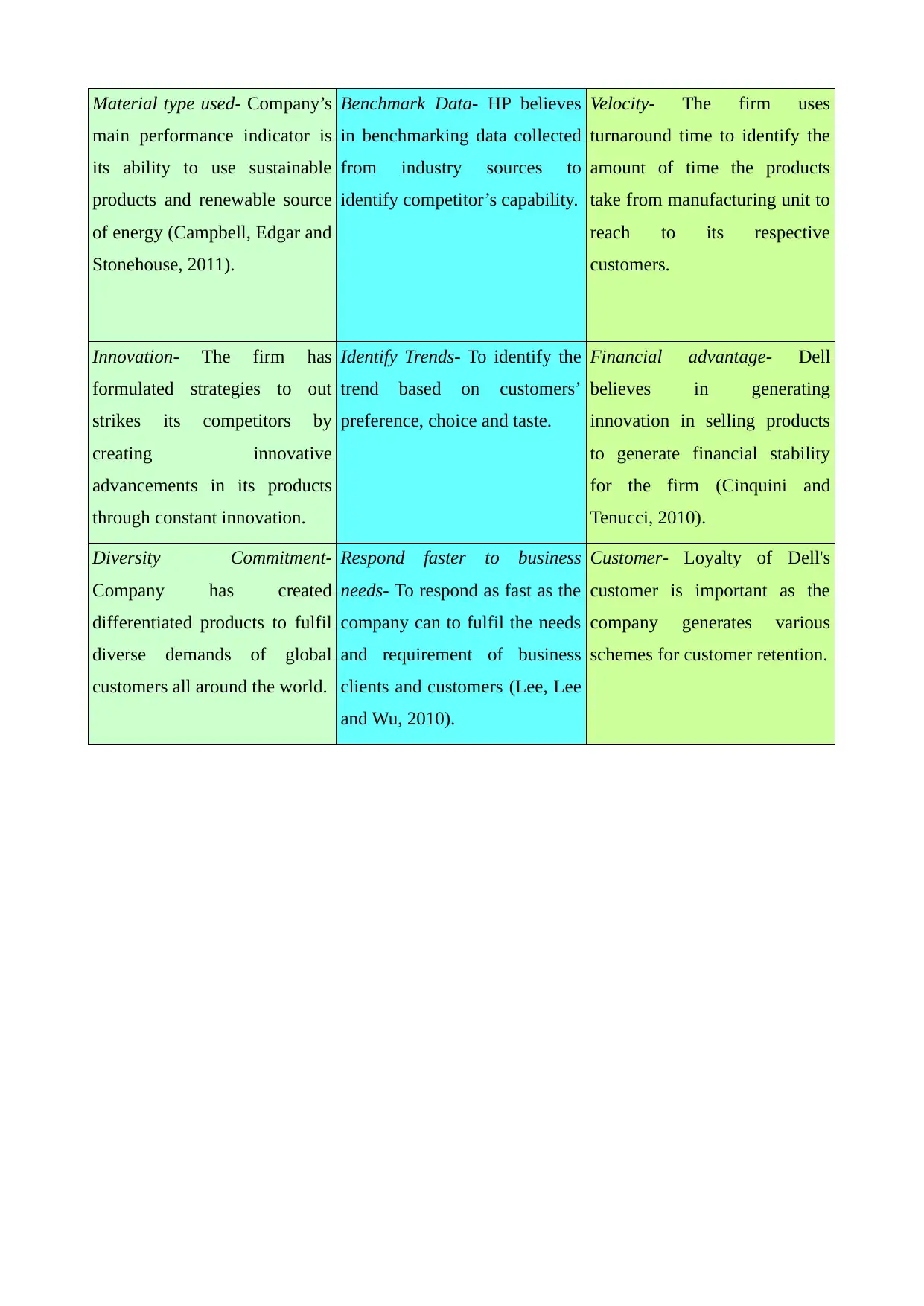
Material type used- Company’s
main performance indicator is
its ability to use sustainable
products and renewable source
of energy (Campbell, Edgar and
Stonehouse, 2011).
Benchmark Data- HP believes
in benchmarking data collected
from industry sources to
identify competitor’s capability.
Velocity- The firm uses
turnaround time to identify the
amount of time the products
take from manufacturing unit to
reach to its respective
customers.
Innovation- The firm has
formulated strategies to out
strikes its competitors by
creating innovative
advancements in its products
through constant innovation.
Identify Trends- To identify the
trend based on customers’
preference, choice and taste.
Financial advantage- Dell
believes in generating
innovation in selling products
to generate financial stability
for the firm (Cinquini and
Tenucci, 2010).
Diversity Commitment-
Company has created
differentiated products to fulfil
diverse demands of global
customers all around the world.
Respond faster to business
needs- To respond as fast as the
company can to fulfil the needs
and requirement of business
clients and customers (Lee, Lee
and Wu, 2010).
Customer- Loyalty of Dell's
customer is important as the
company generates various
schemes for customer retention.
main performance indicator is
its ability to use sustainable
products and renewable source
of energy (Campbell, Edgar and
Stonehouse, 2011).
Benchmark Data- HP believes
in benchmarking data collected
from industry sources to
identify competitor’s capability.
Velocity- The firm uses
turnaround time to identify the
amount of time the products
take from manufacturing unit to
reach to its respective
customers.
Innovation- The firm has
formulated strategies to out
strikes its competitors by
creating innovative
advancements in its products
through constant innovation.
Identify Trends- To identify the
trend based on customers’
preference, choice and taste.
Financial advantage- Dell
believes in generating
innovation in selling products
to generate financial stability
for the firm (Cinquini and
Tenucci, 2010).
Diversity Commitment-
Company has created
differentiated products to fulfil
diverse demands of global
customers all around the world.
Respond faster to business
needs- To respond as fast as the
company can to fulfil the needs
and requirement of business
clients and customers (Lee, Lee
and Wu, 2010).
Customer- Loyalty of Dell's
customer is important as the
company generates various
schemes for customer retention.
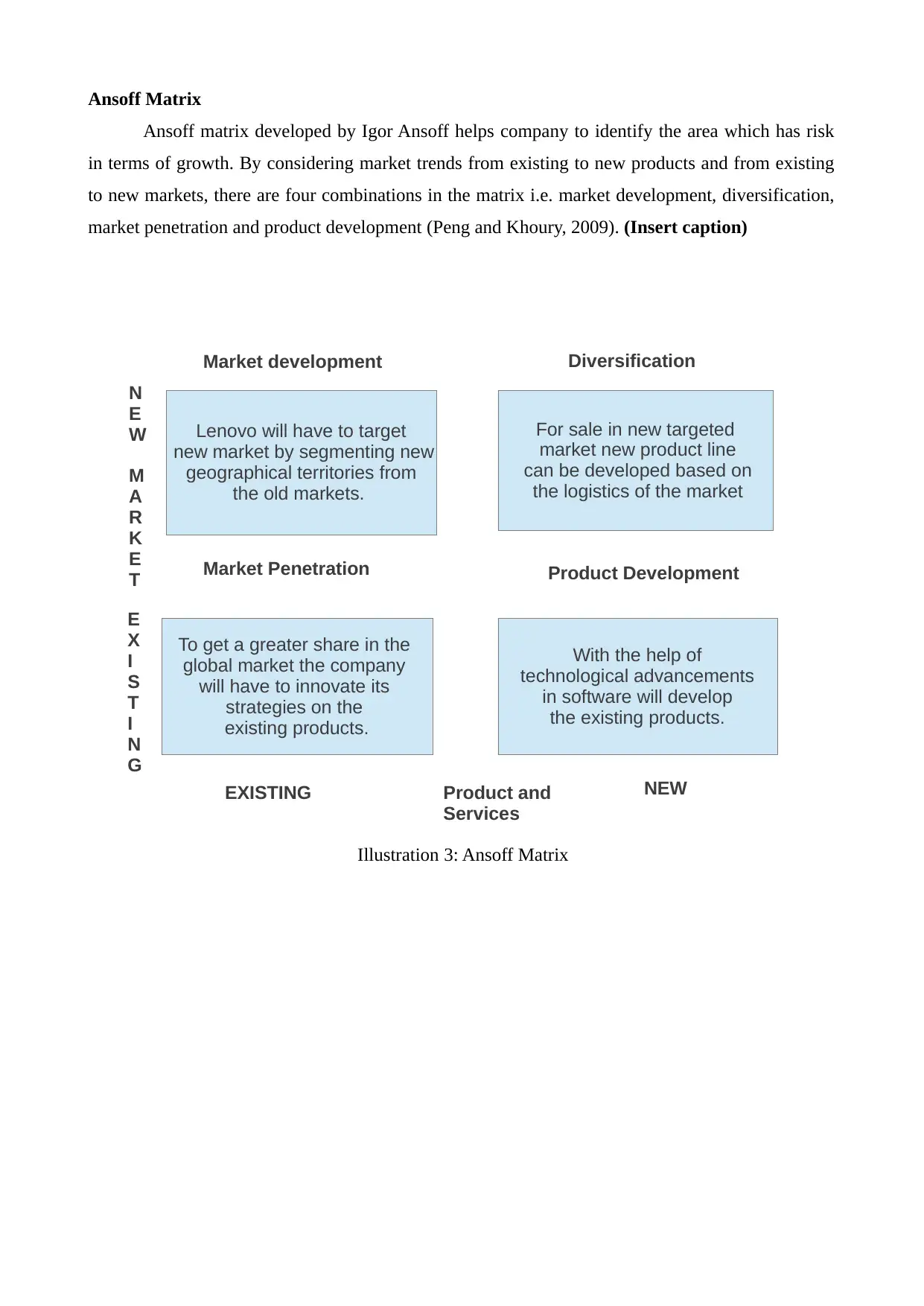
Ansoff Matrix
Ansoff matrix developed by Igor Ansoff helps company to identify the area which has risk
in terms of growth. By considering market trends from existing to new products and from existing
to new markets, there are four combinations in the matrix i.e. market development, diversification,
market penetration and product development (Peng and Khoury, 2009). (Insert caption)
Lenovo will have to target
new market by segmenting new
geographical territories from
the old markets.
For sale in new targeted
market new product line
can be developed based on
the logistics of the market
To get a greater share in the
global market the company
will have to innovate its
strategies on the
existing products.
With the help of
technological advancements
in software will develop
the existing products.
Market development Diversification
Market Penetration Product Development
N
E
W
E
X
I
S
T
I
N
G
EXISTING NEW
M
A
R
K
E
T
Product and
Services
Illustration 3: Ansoff Matrix
Ansoff matrix developed by Igor Ansoff helps company to identify the area which has risk
in terms of growth. By considering market trends from existing to new products and from existing
to new markets, there are four combinations in the matrix i.e. market development, diversification,
market penetration and product development (Peng and Khoury, 2009). (Insert caption)
Lenovo will have to target
new market by segmenting new
geographical territories from
the old markets.
For sale in new targeted
market new product line
can be developed based on
the logistics of the market
To get a greater share in the
global market the company
will have to innovate its
strategies on the
existing products.
With the help of
technological advancements
in software will develop
the existing products.
Market development Diversification
Market Penetration Product Development
N
E
W
E
X
I
S
T
I
N
G
EXISTING NEW
M
A
R
K
E
T
Product and
Services
Illustration 3: Ansoff Matrix
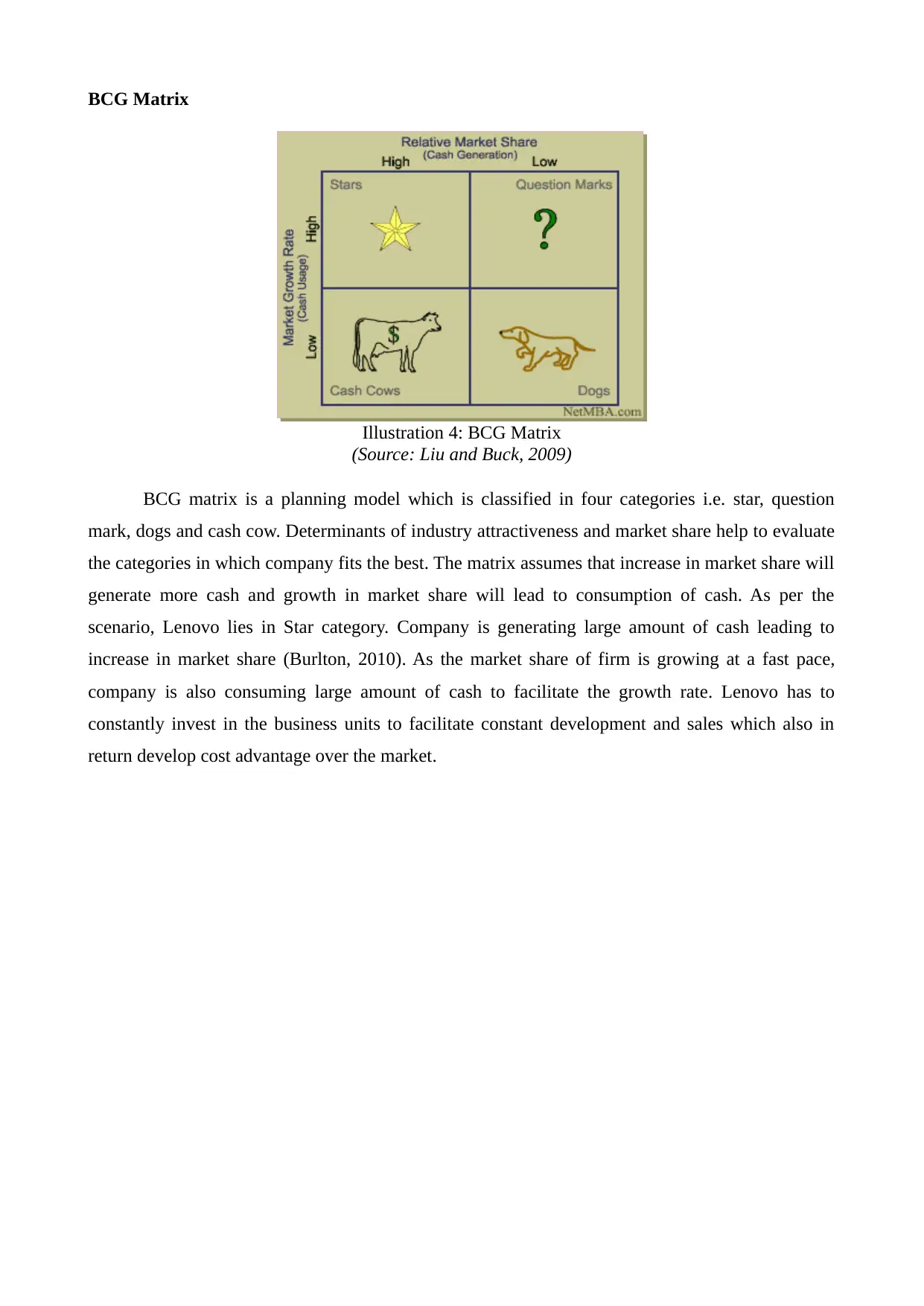
BCG Matrix
BCG matrix is a planning model which is classified in four categories i.e. star, question
mark, dogs and cash cow. Determinants of industry attractiveness and market share help to evaluate
the categories in which company fits the best. The matrix assumes that increase in market share will
generate more cash and growth in market share will lead to consumption of cash. As per the
scenario, Lenovo lies in Star category. Company is generating large amount of cash leading to
increase in market share (Burlton, 2010). As the market share of firm is growing at a fast pace,
company is also consuming large amount of cash to facilitate the growth rate. Lenovo has to
constantly invest in the business units to facilitate constant development and sales which also in
return develop cost advantage over the market.
Illustration 4: BCG Matrix
(Source: Liu and Buck, 2009)
BCG matrix is a planning model which is classified in four categories i.e. star, question
mark, dogs and cash cow. Determinants of industry attractiveness and market share help to evaluate
the categories in which company fits the best. The matrix assumes that increase in market share will
generate more cash and growth in market share will lead to consumption of cash. As per the
scenario, Lenovo lies in Star category. Company is generating large amount of cash leading to
increase in market share (Burlton, 2010). As the market share of firm is growing at a fast pace,
company is also consuming large amount of cash to facilitate the growth rate. Lenovo has to
constantly invest in the business units to facilitate constant development and sales which also in
return develop cost advantage over the market.
Illustration 4: BCG Matrix
(Source: Liu and Buck, 2009)
Secure Best Marks with AI Grader
Need help grading? Try our AI Grader for instant feedback on your assignments.
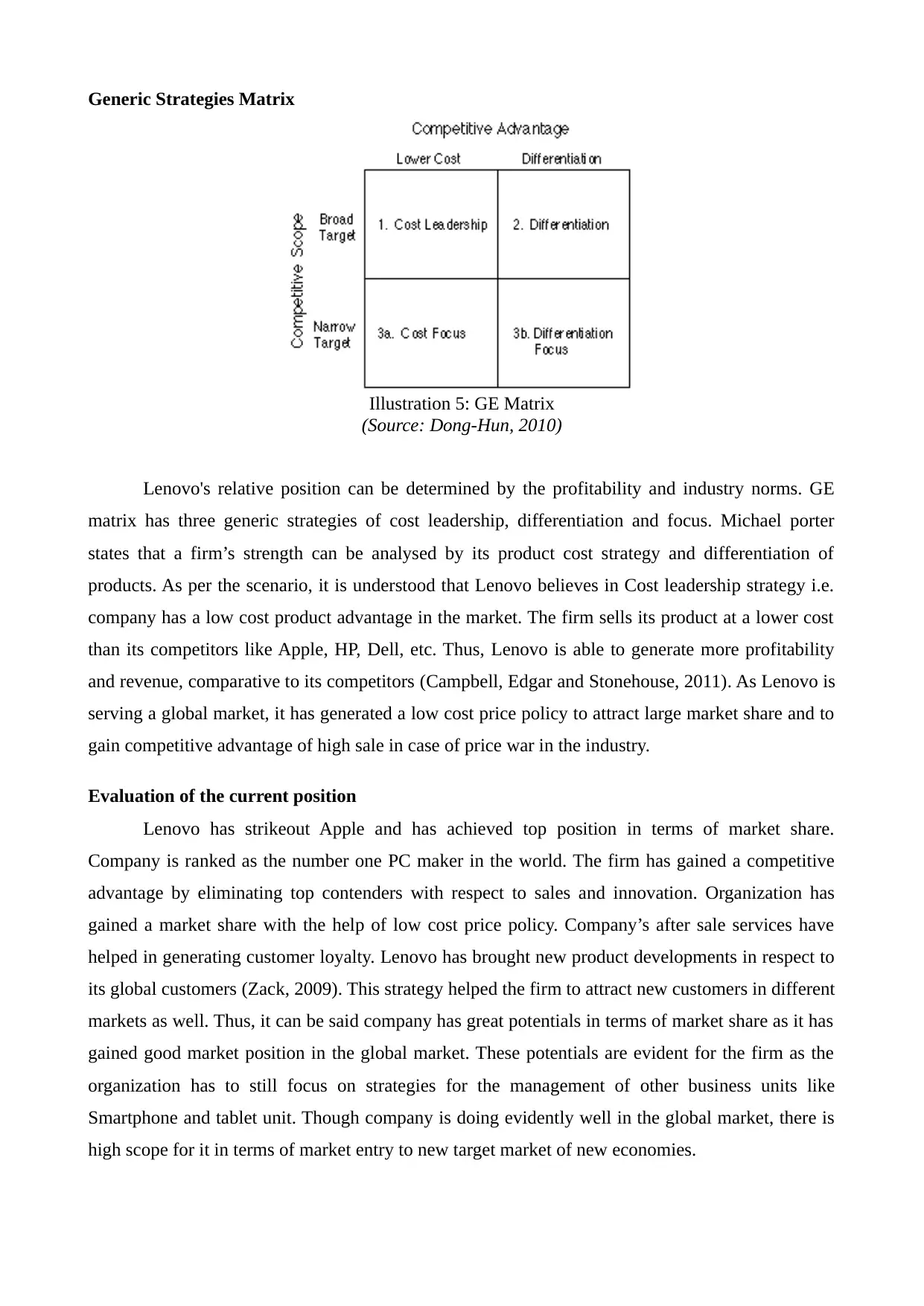
Generic Strategies Matrix
Lenovo's relative position can be determined by the profitability and industry norms. GE
matrix has three generic strategies of cost leadership, differentiation and focus. Michael porter
states that a firm’s strength can be analysed by its product cost strategy and differentiation of
products. As per the scenario, it is understood that Lenovo believes in Cost leadership strategy i.e.
company has a low cost product advantage in the market. The firm sells its product at a lower cost
than its competitors like Apple, HP, Dell, etc. Thus, Lenovo is able to generate more profitability
and revenue, comparative to its competitors (Campbell, Edgar and Stonehouse, 2011). As Lenovo is
serving a global market, it has generated a low cost price policy to attract large market share and to
gain competitive advantage of high sale in case of price war in the industry.
Evaluation of the current position
Lenovo has strikeout Apple and has achieved top position in terms of market share.
Company is ranked as the number one PC maker in the world. The firm has gained a competitive
advantage by eliminating top contenders with respect to sales and innovation. Organization has
gained a market share with the help of low cost price policy. Company’s after sale services have
helped in generating customer loyalty. Lenovo has brought new product developments in respect to
its global customers (Zack, 2009). This strategy helped the firm to attract new customers in different
markets as well. Thus, it can be said company has great potentials in terms of market share as it has
gained good market position in the global market. These potentials are evident for the firm as the
organization has to still focus on strategies for the management of other business units like
Smartphone and tablet unit. Though company is doing evidently well in the global market, there is
high scope for it in terms of market entry to new target market of new economies.
Illustration 5: GE Matrix
(Source: Dong-Hun, 2010)
Lenovo's relative position can be determined by the profitability and industry norms. GE
matrix has three generic strategies of cost leadership, differentiation and focus. Michael porter
states that a firm’s strength can be analysed by its product cost strategy and differentiation of
products. As per the scenario, it is understood that Lenovo believes in Cost leadership strategy i.e.
company has a low cost product advantage in the market. The firm sells its product at a lower cost
than its competitors like Apple, HP, Dell, etc. Thus, Lenovo is able to generate more profitability
and revenue, comparative to its competitors (Campbell, Edgar and Stonehouse, 2011). As Lenovo is
serving a global market, it has generated a low cost price policy to attract large market share and to
gain competitive advantage of high sale in case of price war in the industry.
Evaluation of the current position
Lenovo has strikeout Apple and has achieved top position in terms of market share.
Company is ranked as the number one PC maker in the world. The firm has gained a competitive
advantage by eliminating top contenders with respect to sales and innovation. Organization has
gained a market share with the help of low cost price policy. Company’s after sale services have
helped in generating customer loyalty. Lenovo has brought new product developments in respect to
its global customers (Zack, 2009). This strategy helped the firm to attract new customers in different
markets as well. Thus, it can be said company has great potentials in terms of market share as it has
gained good market position in the global market. These potentials are evident for the firm as the
organization has to still focus on strategies for the management of other business units like
Smartphone and tablet unit. Though company is doing evidently well in the global market, there is
high scope for it in terms of market entry to new target market of new economies.
Illustration 5: GE Matrix
(Source: Dong-Hun, 2010)
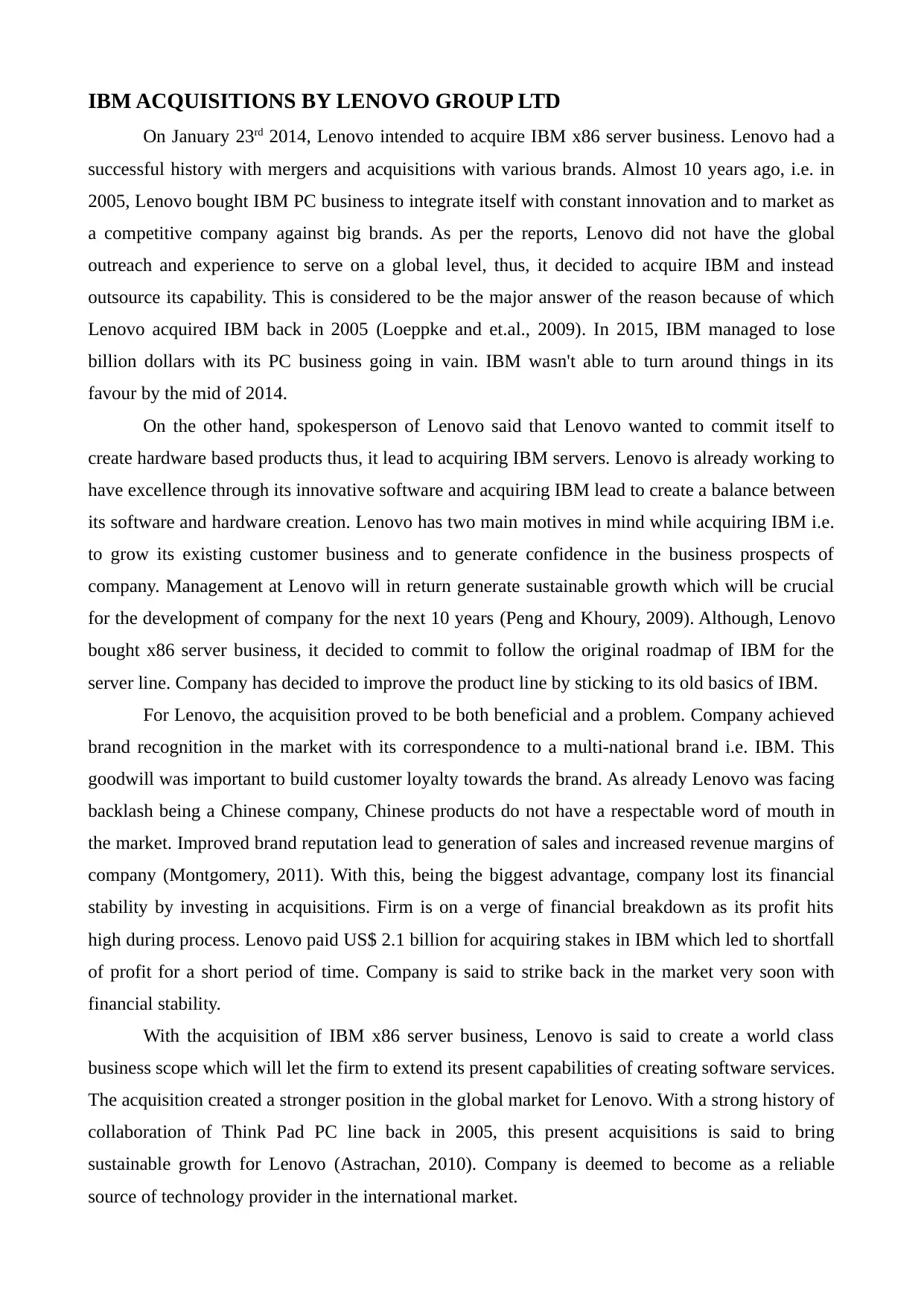
IBM ACQUISITIONS BY LENOVO GROUP LTD
On January 23rd 2014, Lenovo intended to acquire IBM x86 server business. Lenovo had a
successful history with mergers and acquisitions with various brands. Almost 10 years ago, i.e. in
2005, Lenovo bought IBM PC business to integrate itself with constant innovation and to market as
a competitive company against big brands. As per the reports, Lenovo did not have the global
outreach and experience to serve on a global level, thus, it decided to acquire IBM and instead
outsource its capability. This is considered to be the major answer of the reason because of which
Lenovo acquired IBM back in 2005 (Loeppke and et.al., 2009). In 2015, IBM managed to lose
billion dollars with its PC business going in vain. IBM wasn't able to turn around things in its
favour by the mid of 2014.
On the other hand, spokesperson of Lenovo said that Lenovo wanted to commit itself to
create hardware based products thus, it lead to acquiring IBM servers. Lenovo is already working to
have excellence through its innovative software and acquiring IBM lead to create a balance between
its software and hardware creation. Lenovo has two main motives in mind while acquiring IBM i.e.
to grow its existing customer business and to generate confidence in the business prospects of
company. Management at Lenovo will in return generate sustainable growth which will be crucial
for the development of company for the next 10 years (Peng and Khoury, 2009). Although, Lenovo
bought x86 server business, it decided to commit to follow the original roadmap of IBM for the
server line. Company has decided to improve the product line by sticking to its old basics of IBM.
For Lenovo, the acquisition proved to be both beneficial and a problem. Company achieved
brand recognition in the market with its correspondence to a multi-national brand i.e. IBM. This
goodwill was important to build customer loyalty towards the brand. As already Lenovo was facing
backlash being a Chinese company, Chinese products do not have a respectable word of mouth in
the market. Improved brand reputation lead to generation of sales and increased revenue margins of
company (Montgomery, 2011). With this, being the biggest advantage, company lost its financial
stability by investing in acquisitions. Firm is on a verge of financial breakdown as its profit hits
high during process. Lenovo paid US$ 2.1 billion for acquiring stakes in IBM which led to shortfall
of profit for a short period of time. Company is said to strike back in the market very soon with
financial stability.
With the acquisition of IBM x86 server business, Lenovo is said to create a world class
business scope which will let the firm to extend its present capabilities of creating software services.
The acquisition created a stronger position in the global market for Lenovo. With a strong history of
collaboration of Think Pad PC line back in 2005, this present acquisitions is said to bring
sustainable growth for Lenovo (Astrachan, 2010). Company is deemed to become as a reliable
source of technology provider in the international market.
On January 23rd 2014, Lenovo intended to acquire IBM x86 server business. Lenovo had a
successful history with mergers and acquisitions with various brands. Almost 10 years ago, i.e. in
2005, Lenovo bought IBM PC business to integrate itself with constant innovation and to market as
a competitive company against big brands. As per the reports, Lenovo did not have the global
outreach and experience to serve on a global level, thus, it decided to acquire IBM and instead
outsource its capability. This is considered to be the major answer of the reason because of which
Lenovo acquired IBM back in 2005 (Loeppke and et.al., 2009). In 2015, IBM managed to lose
billion dollars with its PC business going in vain. IBM wasn't able to turn around things in its
favour by the mid of 2014.
On the other hand, spokesperson of Lenovo said that Lenovo wanted to commit itself to
create hardware based products thus, it lead to acquiring IBM servers. Lenovo is already working to
have excellence through its innovative software and acquiring IBM lead to create a balance between
its software and hardware creation. Lenovo has two main motives in mind while acquiring IBM i.e.
to grow its existing customer business and to generate confidence in the business prospects of
company. Management at Lenovo will in return generate sustainable growth which will be crucial
for the development of company for the next 10 years (Peng and Khoury, 2009). Although, Lenovo
bought x86 server business, it decided to commit to follow the original roadmap of IBM for the
server line. Company has decided to improve the product line by sticking to its old basics of IBM.
For Lenovo, the acquisition proved to be both beneficial and a problem. Company achieved
brand recognition in the market with its correspondence to a multi-national brand i.e. IBM. This
goodwill was important to build customer loyalty towards the brand. As already Lenovo was facing
backlash being a Chinese company, Chinese products do not have a respectable word of mouth in
the market. Improved brand reputation lead to generation of sales and increased revenue margins of
company (Montgomery, 2011). With this, being the biggest advantage, company lost its financial
stability by investing in acquisitions. Firm is on a verge of financial breakdown as its profit hits
high during process. Lenovo paid US$ 2.1 billion for acquiring stakes in IBM which led to shortfall
of profit for a short period of time. Company is said to strike back in the market very soon with
financial stability.
With the acquisition of IBM x86 server business, Lenovo is said to create a world class
business scope which will let the firm to extend its present capabilities of creating software services.
The acquisition created a stronger position in the global market for Lenovo. With a strong history of
collaboration of Think Pad PC line back in 2005, this present acquisitions is said to bring
sustainable growth for Lenovo (Astrachan, 2010). Company is deemed to become as a reliable
source of technology provider in the international market.
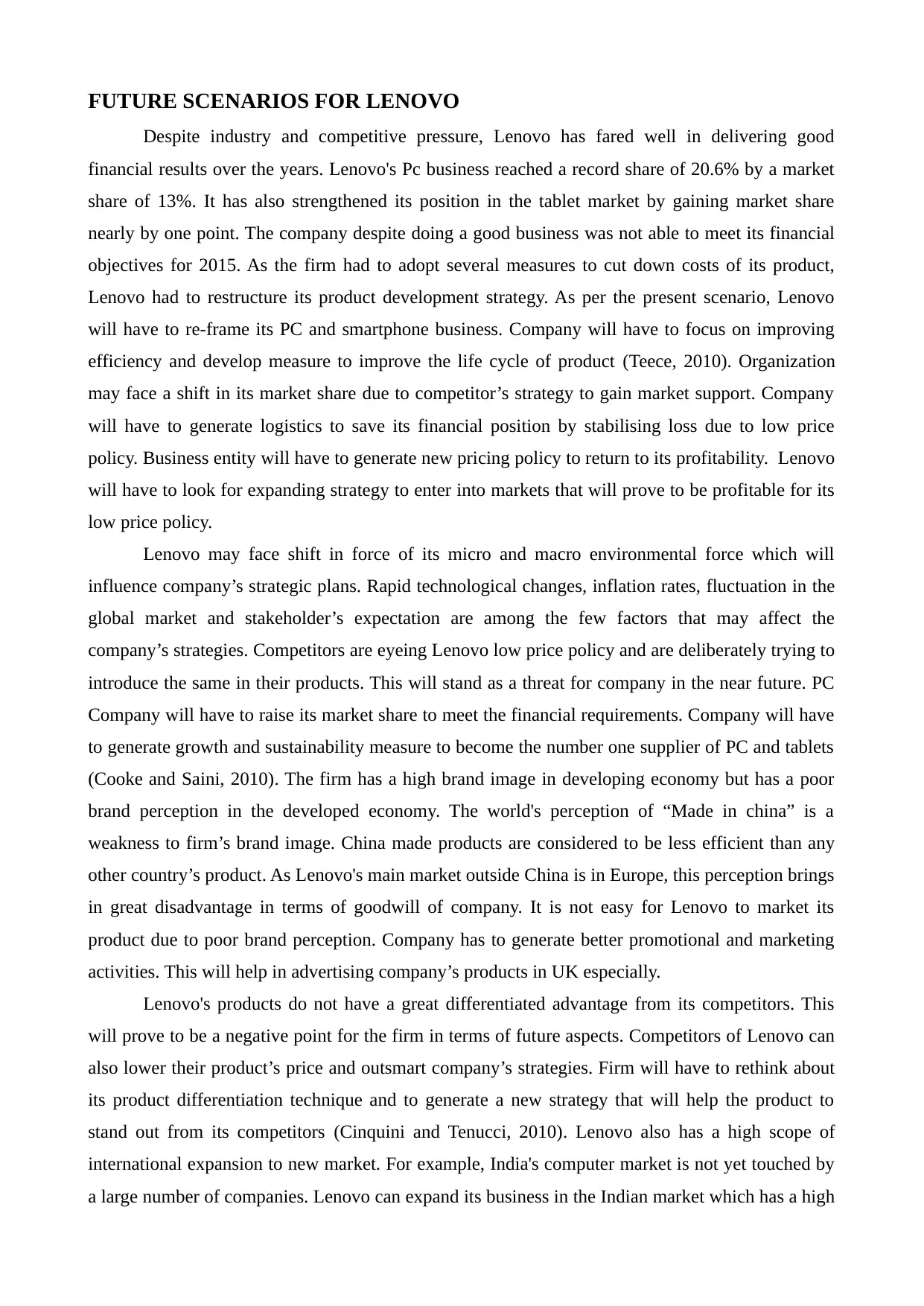
FUTURE SCENARIOS FOR LENOVO
Despite industry and competitive pressure, Lenovo has fared well in delivering good
financial results over the years. Lenovo's Pc business reached a record share of 20.6% by a market
share of 13%. It has also strengthened its position in the tablet market by gaining market share
nearly by one point. The company despite doing a good business was not able to meet its financial
objectives for 2015. As the firm had to adopt several measures to cut down costs of its product,
Lenovo had to restructure its product development strategy. As per the present scenario, Lenovo
will have to re-frame its PC and smartphone business. Company will have to focus on improving
efficiency and develop measure to improve the life cycle of product (Teece, 2010). Organization
may face a shift in its market share due to competitor’s strategy to gain market support. Company
will have to generate logistics to save its financial position by stabilising loss due to low price
policy. Business entity will have to generate new pricing policy to return to its profitability. Lenovo
will have to look for expanding strategy to enter into markets that will prove to be profitable for its
low price policy.
Lenovo may face shift in force of its micro and macro environmental force which will
influence company’s strategic plans. Rapid technological changes, inflation rates, fluctuation in the
global market and stakeholder’s expectation are among the few factors that may affect the
company’s strategies. Competitors are eyeing Lenovo low price policy and are deliberately trying to
introduce the same in their products. This will stand as a threat for company in the near future. PC
Company will have to raise its market share to meet the financial requirements. Company will have
to generate growth and sustainability measure to become the number one supplier of PC and tablets
(Cooke and Saini, 2010). The firm has a high brand image in developing economy but has a poor
brand perception in the developed economy. The world's perception of “Made in china” is a
weakness to firm’s brand image. China made products are considered to be less efficient than any
other country’s product. As Lenovo's main market outside China is in Europe, this perception brings
in great disadvantage in terms of goodwill of company. It is not easy for Lenovo to market its
product due to poor brand perception. Company has to generate better promotional and marketing
activities. This will help in advertising company’s products in UK especially.
Lenovo's products do not have a great differentiated advantage from its competitors. This
will prove to be a negative point for the firm in terms of future aspects. Competitors of Lenovo can
also lower their product’s price and outsmart company’s strategies. Firm will have to rethink about
its product differentiation technique and to generate a new strategy that will help the product to
stand out from its competitors (Cinquini and Tenucci, 2010). Lenovo also has a high scope of
international expansion to new market. For example, India's computer market is not yet touched by
a large number of companies. Lenovo can expand its business in the Indian market which has a high
Despite industry and competitive pressure, Lenovo has fared well in delivering good
financial results over the years. Lenovo's Pc business reached a record share of 20.6% by a market
share of 13%. It has also strengthened its position in the tablet market by gaining market share
nearly by one point. The company despite doing a good business was not able to meet its financial
objectives for 2015. As the firm had to adopt several measures to cut down costs of its product,
Lenovo had to restructure its product development strategy. As per the present scenario, Lenovo
will have to re-frame its PC and smartphone business. Company will have to focus on improving
efficiency and develop measure to improve the life cycle of product (Teece, 2010). Organization
may face a shift in its market share due to competitor’s strategy to gain market support. Company
will have to generate logistics to save its financial position by stabilising loss due to low price
policy. Business entity will have to generate new pricing policy to return to its profitability. Lenovo
will have to look for expanding strategy to enter into markets that will prove to be profitable for its
low price policy.
Lenovo may face shift in force of its micro and macro environmental force which will
influence company’s strategic plans. Rapid technological changes, inflation rates, fluctuation in the
global market and stakeholder’s expectation are among the few factors that may affect the
company’s strategies. Competitors are eyeing Lenovo low price policy and are deliberately trying to
introduce the same in their products. This will stand as a threat for company in the near future. PC
Company will have to raise its market share to meet the financial requirements. Company will have
to generate growth and sustainability measure to become the number one supplier of PC and tablets
(Cooke and Saini, 2010). The firm has a high brand image in developing economy but has a poor
brand perception in the developed economy. The world's perception of “Made in china” is a
weakness to firm’s brand image. China made products are considered to be less efficient than any
other country’s product. As Lenovo's main market outside China is in Europe, this perception brings
in great disadvantage in terms of goodwill of company. It is not easy for Lenovo to market its
product due to poor brand perception. Company has to generate better promotional and marketing
activities. This will help in advertising company’s products in UK especially.
Lenovo's products do not have a great differentiated advantage from its competitors. This
will prove to be a negative point for the firm in terms of future aspects. Competitors of Lenovo can
also lower their product’s price and outsmart company’s strategies. Firm will have to rethink about
its product differentiation technique and to generate a new strategy that will help the product to
stand out from its competitors (Cinquini and Tenucci, 2010). Lenovo also has a high scope of
international expansion to new market. For example, India's computer market is not yet touched by
a large number of companies. Lenovo can expand its business in the Indian market which has a high
Paraphrase This Document
Need a fresh take? Get an instant paraphrase of this document with our AI Paraphraser
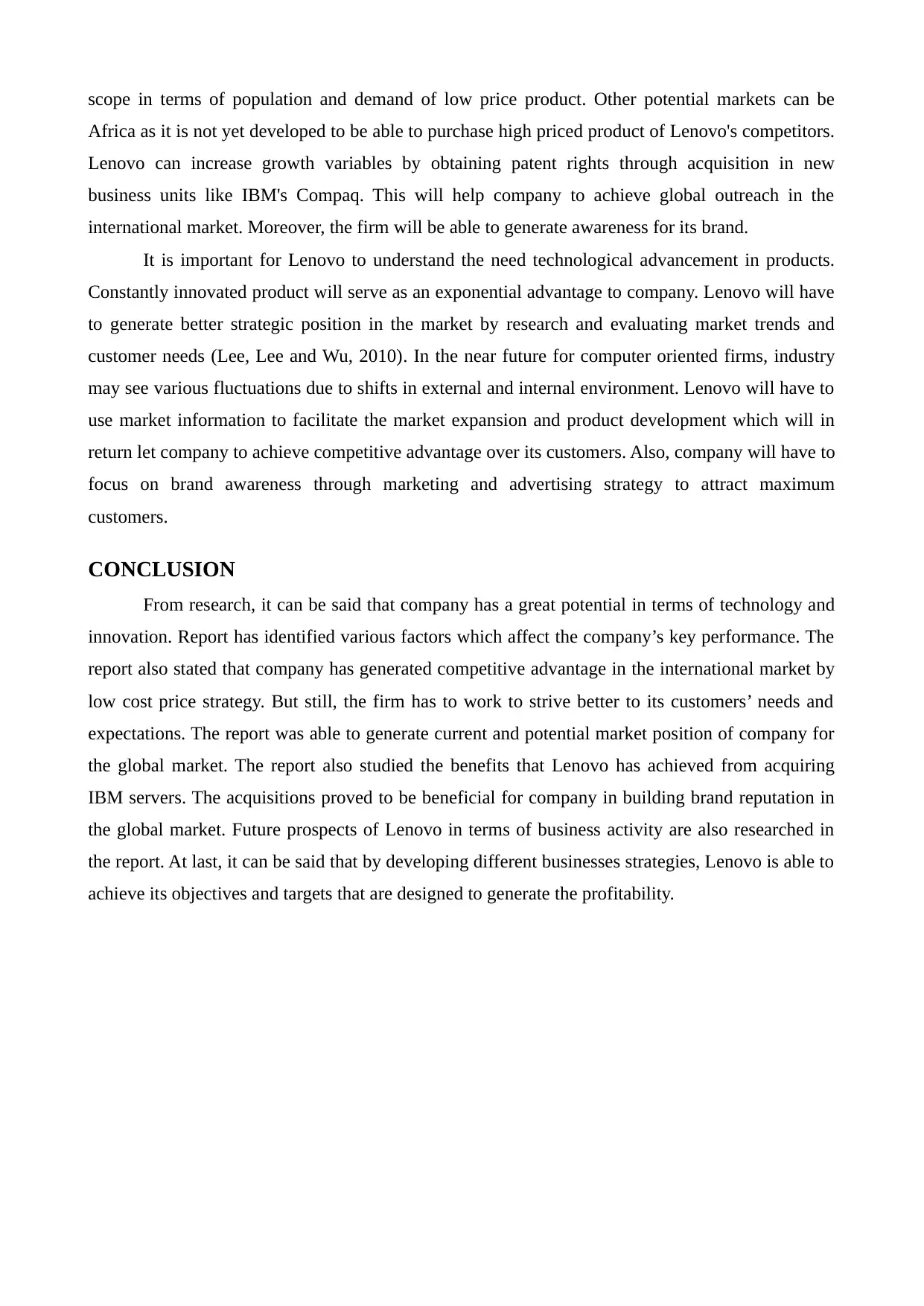
scope in terms of population and demand of low price product. Other potential markets can be
Africa as it is not yet developed to be able to purchase high priced product of Lenovo's competitors.
Lenovo can increase growth variables by obtaining patent rights through acquisition in new
business units like IBM's Compaq. This will help company to achieve global outreach in the
international market. Moreover, the firm will be able to generate awareness for its brand.
It is important for Lenovo to understand the need technological advancement in products.
Constantly innovated product will serve as an exponential advantage to company. Lenovo will have
to generate better strategic position in the market by research and evaluating market trends and
customer needs (Lee, Lee and Wu, 2010). In the near future for computer oriented firms, industry
may see various fluctuations due to shifts in external and internal environment. Lenovo will have to
use market information to facilitate the market expansion and product development which will in
return let company to achieve competitive advantage over its customers. Also, company will have to
focus on brand awareness through marketing and advertising strategy to attract maximum
customers.
CONCLUSION
From research, it can be said that company has a great potential in terms of technology and
innovation. Report has identified various factors which affect the company’s key performance. The
report also stated that company has generated competitive advantage in the international market by
low cost price strategy. But still, the firm has to work to strive better to its customers’ needs and
expectations. The report was able to generate current and potential market position of company for
the global market. The report also studied the benefits that Lenovo has achieved from acquiring
IBM servers. The acquisitions proved to be beneficial for company in building brand reputation in
the global market. Future prospects of Lenovo in terms of business activity are also researched in
the report. At last, it can be said that by developing different businesses strategies, Lenovo is able to
achieve its objectives and targets that are designed to generate the profitability.
Africa as it is not yet developed to be able to purchase high priced product of Lenovo's competitors.
Lenovo can increase growth variables by obtaining patent rights through acquisition in new
business units like IBM's Compaq. This will help company to achieve global outreach in the
international market. Moreover, the firm will be able to generate awareness for its brand.
It is important for Lenovo to understand the need technological advancement in products.
Constantly innovated product will serve as an exponential advantage to company. Lenovo will have
to generate better strategic position in the market by research and evaluating market trends and
customer needs (Lee, Lee and Wu, 2010). In the near future for computer oriented firms, industry
may see various fluctuations due to shifts in external and internal environment. Lenovo will have to
use market information to facilitate the market expansion and product development which will in
return let company to achieve competitive advantage over its customers. Also, company will have to
focus on brand awareness through marketing and advertising strategy to attract maximum
customers.
CONCLUSION
From research, it can be said that company has a great potential in terms of technology and
innovation. Report has identified various factors which affect the company’s key performance. The
report also stated that company has generated competitive advantage in the international market by
low cost price strategy. But still, the firm has to work to strive better to its customers’ needs and
expectations. The report was able to generate current and potential market position of company for
the global market. The report also studied the benefits that Lenovo has achieved from acquiring
IBM servers. The acquisitions proved to be beneficial for company in building brand reputation in
the global market. Future prospects of Lenovo in terms of business activity are also researched in
the report. At last, it can be said that by developing different businesses strategies, Lenovo is able to
achieve its objectives and targets that are designed to generate the profitability.

REFERENCES
Books and Journals
Ackermann, S. and Audretsch, D. B. eds., 2013. The economics of small firms: A European
challenge. 11. Springer Science & Business Media.
Astrachan, J. H., 2010. Strategy in family business: Toward a multidimensional research agenda.
Journal of Family Business Strategy. 1(1). pp.6-14.
Augier, M. and Teece, D. J., 2009. Dynamic capabilities and the role of managers in business
strategy and economic performance. Organization Science. 20(2). pp.410-421.
Bryson, J. R. and Lombardi, R., 2009. Balancing product and process sustainability against business
profitability: sustainability as a competitive strategy in the property development process.
Business Strategy and the Environment. 18(2). pp.97-107.
Burlton, R., 2010. Delivering business strategy through process management. In Handbook on
Business Process Management 2. pp.5-37
Campbell, D., Edgar, D. and Stonehouse, G., 2011. Business strategy: an introduction. Palgrave
Macmillan.
Cinquini, L. and Tenucci, A., 2010. Strategic management accounting and business strategy: a loose
coupling?. Journal of Accounting & organizational change. 6(2). pp.228-259.
Cooke, F. L. and Saini, D. S., 2010. (How) does the HR strategy support an innovation oriented
business strategy? An investigation of institutional context and organizational practices in
Indian firms. Human Resource Management. 49(3). pp.377-400.
Dong-Hun, L., 2010. Korean Consumer & Society: Growing Popularity of Social Media and
Business Strategy. SERI Quarterly. 3(4). pp.112.
Edwards, V. and Ellison, L., 2009. Corporate property management: aligning real estate with
business strategy. John Wiley & Sons.
Holbeche, L., 2009. Aligning human resources and business strategy. Routledge.
Lee, F. H., Lee, T. Z. and Wu, W. Y., 2010. The relationship between human resource management
practices, business strategy and firm performance: evidence from steel industry in Taiwan.
The International Journal of Human Resource Management. 21(9). ppp.1351-1372.
Liu, X. and Buck, T., 2009. The internationalisation strategies of Chinese firms: Lenovo and BOE.
Journal of Chinese Economic and Business Studies. 7(2). pp.167-181.
Loeppke, R. and et.al., 2009. Health and productivity as a business strategy: a multiemployer study.
Journal of Occupational and Environmental Medicine. 51(4). pp.411-428.
Montgomery, C. A. ed., 2011. Resource-based and evolutionary theories of the firm: towards a
synthesis. Springer Science & Business Media.
Peng, M. W. and Khoury, T.A., 2009. Unbundling the Institution‐Based View of International
Business Strategy.
Reich, B. H. and Benbasat, I., 2013. 10 Measuring the Information Systems–Business Strategy
Books and Journals
Ackermann, S. and Audretsch, D. B. eds., 2013. The economics of small firms: A European
challenge. 11. Springer Science & Business Media.
Astrachan, J. H., 2010. Strategy in family business: Toward a multidimensional research agenda.
Journal of Family Business Strategy. 1(1). pp.6-14.
Augier, M. and Teece, D. J., 2009. Dynamic capabilities and the role of managers in business
strategy and economic performance. Organization Science. 20(2). pp.410-421.
Bryson, J. R. and Lombardi, R., 2009. Balancing product and process sustainability against business
profitability: sustainability as a competitive strategy in the property development process.
Business Strategy and the Environment. 18(2). pp.97-107.
Burlton, R., 2010. Delivering business strategy through process management. In Handbook on
Business Process Management 2. pp.5-37
Campbell, D., Edgar, D. and Stonehouse, G., 2011. Business strategy: an introduction. Palgrave
Macmillan.
Cinquini, L. and Tenucci, A., 2010. Strategic management accounting and business strategy: a loose
coupling?. Journal of Accounting & organizational change. 6(2). pp.228-259.
Cooke, F. L. and Saini, D. S., 2010. (How) does the HR strategy support an innovation oriented
business strategy? An investigation of institutional context and organizational practices in
Indian firms. Human Resource Management. 49(3). pp.377-400.
Dong-Hun, L., 2010. Korean Consumer & Society: Growing Popularity of Social Media and
Business Strategy. SERI Quarterly. 3(4). pp.112.
Edwards, V. and Ellison, L., 2009. Corporate property management: aligning real estate with
business strategy. John Wiley & Sons.
Holbeche, L., 2009. Aligning human resources and business strategy. Routledge.
Lee, F. H., Lee, T. Z. and Wu, W. Y., 2010. The relationship between human resource management
practices, business strategy and firm performance: evidence from steel industry in Taiwan.
The International Journal of Human Resource Management. 21(9). ppp.1351-1372.
Liu, X. and Buck, T., 2009. The internationalisation strategies of Chinese firms: Lenovo and BOE.
Journal of Chinese Economic and Business Studies. 7(2). pp.167-181.
Loeppke, R. and et.al., 2009. Health and productivity as a business strategy: a multiemployer study.
Journal of Occupational and Environmental Medicine. 51(4). pp.411-428.
Montgomery, C. A. ed., 2011. Resource-based and evolutionary theories of the firm: towards a
synthesis. Springer Science & Business Media.
Peng, M. W. and Khoury, T.A., 2009. Unbundling the Institution‐Based View of International
Business Strategy.
Reich, B. H. and Benbasat, I., 2013. 10 Measuring the Information Systems–Business Strategy
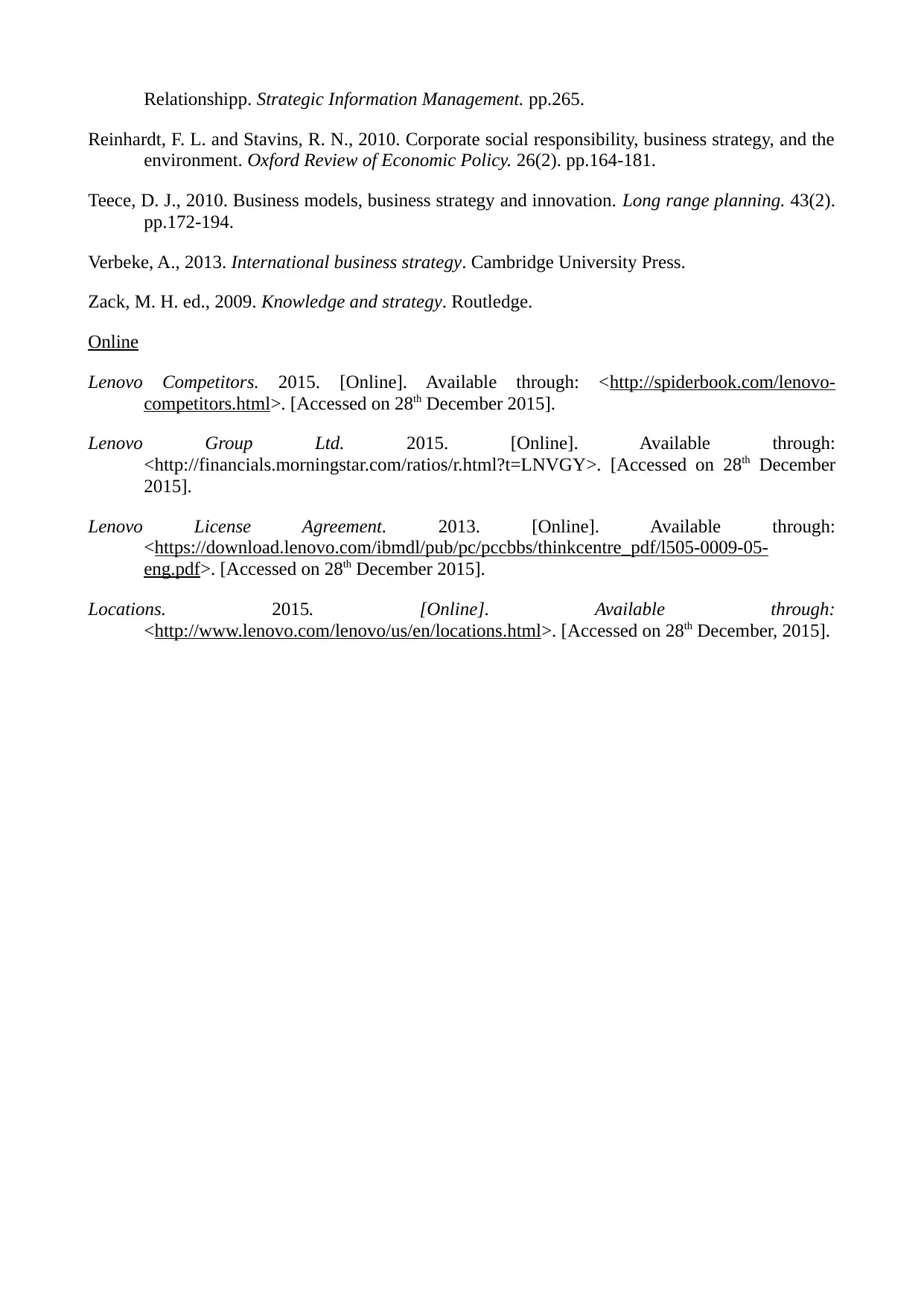
Relationshipp. Strategic Information Management. pp.265.
Reinhardt, F. L. and Stavins, R. N., 2010. Corporate social responsibility, business strategy, and the
environment. Oxford Review of Economic Policy. 26(2). pp.164-181.
Teece, D. J., 2010. Business models, business strategy and innovation. Long range planning. 43(2).
pp.172-194.
Verbeke, A., 2013. International business strategy. Cambridge University Press.
Zack, M. H. ed., 2009. Knowledge and strategy. Routledge.
Online
Lenovo Competitors. 2015. [Online]. Available through: <http://spiderbook.com/lenovo-
competitors.html>. [Accessed on 28th December 2015].
Lenovo Group Ltd. 2015. [Online]. Available through:
<http://financials.morningstar.com/ratios/r.html?t=LNVGY>. [Accessed on 28th December
2015].
Lenovo License Agreement. 2013. [Online]. Available through:
<https://download.lenovo.com/ibmdl/pub/pc/pccbbs/thinkcentre_pdf/l505-0009-05-
eng.pdf>. [Accessed on 28th December 2015].
Locations. 2015. [Online]. Available through:
<http://www.lenovo.com/lenovo/us/en/locations.html>. [Accessed on 28th December, 2015].
Reinhardt, F. L. and Stavins, R. N., 2010. Corporate social responsibility, business strategy, and the
environment. Oxford Review of Economic Policy. 26(2). pp.164-181.
Teece, D. J., 2010. Business models, business strategy and innovation. Long range planning. 43(2).
pp.172-194.
Verbeke, A., 2013. International business strategy. Cambridge University Press.
Zack, M. H. ed., 2009. Knowledge and strategy. Routledge.
Online
Lenovo Competitors. 2015. [Online]. Available through: <http://spiderbook.com/lenovo-
competitors.html>. [Accessed on 28th December 2015].
Lenovo Group Ltd. 2015. [Online]. Available through:
<http://financials.morningstar.com/ratios/r.html?t=LNVGY>. [Accessed on 28th December
2015].
Lenovo License Agreement. 2013. [Online]. Available through:
<https://download.lenovo.com/ibmdl/pub/pc/pccbbs/thinkcentre_pdf/l505-0009-05-
eng.pdf>. [Accessed on 28th December 2015].
Locations. 2015. [Online]. Available through:
<http://www.lenovo.com/lenovo/us/en/locations.html>. [Accessed on 28th December, 2015].
1 out of 16
Related Documents
Your All-in-One AI-Powered Toolkit for Academic Success.
+13062052269
info@desklib.com
Available 24*7 on WhatsApp / Email
![[object Object]](/_next/static/media/star-bottom.7253800d.svg)
Unlock your academic potential
© 2024 | Zucol Services PVT LTD | All rights reserved.





